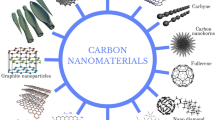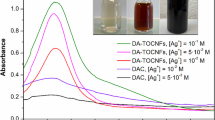Abstract
In this study, silver/graphene oxide (Ag/GO) nanocomposite was synthesized via the in − situ method using nanocellulose (NCs) obtained from sugarcane bagasse as a reducing agent. The synthesis conditions, including AgNO3:NCs mass ratio, temperature, and reaction time, were investigated. The results showed that the suitable condition was 1:1 in the AgNO3:NCs mass ratio at 60 °C for 60 min. The results indicated that the silver nanoparticles (AgNPs) were evenly distributed on the GO sheets with a size of 5 − 30 nm. Besides, the cytotoxicity of the Ag/GO nanocomposite was also assessed with three cell lines, including human embryonic kidney cells (HEK − 293), liver cancer cells (Hep − G2), and lung cancer cells (A549). Ag/GO possesses the ability to inhibit cancer cells of Hep-G2 and A549 with respective IC50 values of 86.11 ± 1.74 μg/mL and 106.85 ± 2.15 μg/mL. Therewithal, the antibacterial acrylic fabric (AF) was fabricated by dip − coating in an Ag/GO suspension (Ag/GO/AF). The Ag/GO/AF was hydrophobically modified with 5 g/L of stearic acid (Ag/GO/AF − SA) in ethanol solvent for 180 min, resulting in the fabric having high hydrophobicity with a contact angle of 116°. Additionally, the plate diffusion method was used to evaluate the antibacterial activity of fabrics against two strains of Pseudomonas aeruginosa (P. aeruginosa) and Staphylococcus aureus (S. aureus) bacteria. The results showed that the Ag/GO/AF − SA has an antibacterial ability with a large antibacterial diameter of 24 ± 0.34 mm and 25 ± 0.35 mm for P. aeruginosa and S. aureus, respectively. Moreover, the colorfastness of Ag/GO/AF and Ag/GO/AF − SA also possess high durability.

















Similar content being viewed by others
References
Tsou C-H, Yao W-H, Hung W-S, Suen M-C, De Guzman M, Chen J, Tsou C-Y, Wang RY, Chen J-C, Wu C-S (2018) Innovative Plasma Process of Grafting Methyl Diallyl Ammonium Salt onto Polypropylene to Impart Antibacterial and Hydrophilic Surface Properties. Ind Eng Chem Res 57:2537–2545. https://doi.org/10.1021/acs.iecr.7b04693
Atef El-Sayed A, El Gabry LK, Allam OG (2010) Application of prepared waterborne polyurethane extended with chitosan to impart antibacterial properties to acrylic fabrics. J Mater Sci Mater Med 21:507–514
Ren Y, Fu R, Fang K, Xie R, Hao L, Chen W, Shi Z (2021) Clean dyeing of acrylic fabric by sustainable red bacterial pigment based on nano-suspension system. J Clean Prod 281:125295
Chen R, Cheng Z, Hu Y, Jiang L, Pan P, Mao J, Ni C (2020) Discarded clothing acrylic yarns: Low-cost raw materials for deformable c nanofibers applied to flexible sodium-ion batteries. Electrochim Acta 359:136988
Belliveau RG, DeJong SA, Boltin ND, Lu Z, Cassidy BM, Morgan SL, Myrick ML (2020) Mid-infrared emissivity of nylon, cotton, acrylic, and polyester fabrics as a function of moisture content. Text Res J 90:1431–1445
Tan L, Sin LT, Bee S, Ratnam CT, Woo K, Tee T, Rahmat AR (2019) A review of antimicrobial fabric containing nanostructures metal-based compound. J Vinyl Addit Technol 25:E3–E27
Donga S, Chanda S (2021) Facile green synthesis of silver nanoparticles using Mangifera indica seed aqueous extract and its antimicrobial, antioxidant and cytotoxic potential (3-in-1 system). Artif Cells, Nanomed Biotechnol 49:292–302
Parandhaman T, Choudhary P, Ramalingam B, Schmidt M, Janardhanam S, Das SK (2021) Antibacterial and Antibiofouling Activities of Antimicrobial Peptide-Functionalized Graphene-Silver Nanocomposites for the Inhibition and Disruption of Staphylococcus aureus Biofilms. ACS Biomater Sci Eng 7:5899–5917
Jeronsia JE, Ragu R, Sowmya R, Mary AJ, Das SJ (2020) Comparative investigation on Camellia Sinensis mediated green synthesis of Ag and Ag/GO nanocomposites for its anticancer and antibacterial efficacy. Surfaces and Interfaces 21:100787
Marcano DC, Kosynkin DV, Berlin JM, Sinitskii A, Sun Z, Slesarev A, Alemany LB, Lu W, Tour JM (2010) Improved Synthesis of Graphene Oxide. ACS Nano 4:4806–4814
Eichhorn SJ, Baillie CA, Zafeiropoulos N, Mwaikambo LY, Ansell MP, al Dufresne A, Entwistle KM, Herrera-Franco PJ, Escamilla GC, Groom L (2001) Current international research into cellulosic fibres and composites. J Mater Sci 36:2107–2131
Rojas J, Bedoya M, Ciro Y (2015) Current trends in the production of cellulose nanoparticles and nanocomposites for biomedical applications. Cellul Asp Curr Trends 193–228
Sullivan EM, Moon RJ, Kalaitzidou K (2015) Processing and characterization of cellulose nanocrystals/polylactic acid nanocomposite films. Materials (Basel) 8:8106–8116
Lani NS, Ngadi N, Johari A, Jusoh M (2014) Isolation, characterization, and application of nanocellulose from oil palm empty fruit bunch fiber as nanocomposites. J Nanomater 2014
Diep TC, Dat NM, Tai LT, Phuc NHT, An NTT, Huong LTT, Hung NG, Hy LD, Oanh DTY, Nam HM (2020) Synthesis of graphene oxide-based silver cotton fabric application for antibacterial activity. Vietnam J Chem 58:844–850
Balouiri M, Sadiki M, Ibnsouda SK (2016) Methods for in vitro evaluating antimicrobial activity: A review. J Pharm Anal 6:71–79
de Souza Lima MM, Borsali R (2004) Rodlike cellulose microcrystals: structure, properties, and applications. Macromol Rapid Commun 25:771–787
Yao J, Li R, Fei J, Cai Y, Li Y, Feng J (2009) Cellulose Whiskers Extracted from Mulberry A Novel Biomass Production. Carbohydr Polym 76:94–99
Huang L, Yang H, Zhang Y, Xiao W (2016) Study on synthesis and antibacterial properties of Ag NPs/GO nanocomposites. J Nanomater 2016
Baker C, Pradhan A, Pakstis L, Pochan DJ, Shah SI (2005) Synthesis and antibacterial properties of silver nanoparticles. J Nanosci Nanotechnol 5:244–249
Sarkar P, Bhui DK, Bar H, Sahoo GP, De SP, Misra A (2009) Synthesis and photophysical study of silver nanoparticles stabilized by unsaturated dicarboxylates. J Lumin 129:704–709
Golsheikh AM, Huang NM, Lim HN, Zakaria R (2014) One-pot sonochemical synthesis of reduced graphene oxide uniformly decorated with ultrafine silver nanoparticles for non-enzymatic detection of H 2 O 2 and optical detection of mercury ions. Rsc Adv 4:36401–36411
Zheng L, Zhang G, Zhang M, Guo S, Liu Z (2012) Preparation and capacitance performance of Ag–graphene based nanocomposite. J Power Sources 201:376–381
Shao W, Liu X, Min H, Dong G, Feng Q, Zuo S (2015) Preparation, characterization, and antibacterial activity of silver nanoparticle-decorated graphene oxide nanocomposite. ACS Appl Mater Interfaces 7:6966–6973
Sfyris D, Sfyris GI, Galiotis C (2017) Stress intrepretation of graphene E-2g and A-1g vibrational modes: theoretical analysis, ArXiv Prepr. https://arxiv.org/abs/1706.04465
Chandraker K, Nagwanshi R, Jadhav SK, Ghosh KK, Satnami ML (2017) Antibacterial properties of amino acid functionalized silver nanoparticles decorated on graphene oxide sheets. Spectrochim Acta Part A Mol Biomol Spectrosc 181:47–54
Pajerski W, Ochonska D, Brzychczy-Wloch M, Indyka P, Jarosz M, Golda-Cepa M, Sojka Z, Kotarba A (2019) Attachment efficiency of gold nanoparticles by Gram-positive and Gram-negative bacterial strains governed by surface charges. J Nanoparticle Res 21:1–12
Linh NTT, Nam NTH, Dat NM, Cong CQ, Viet ND, Trinh DN, Giang NTH, Huong QTT, Phong MT, Hieu NH (2022) Fabrication and antibacterial activity of polyester fabric modified by nanocellulose and graphene oxide-based silver nanoparticles. J Mater Sci 1–19
Linh NTT, Diep TC, Vy TT, Dat NM, Trinh DN, Thinh DB, Viet ND, Hai ND, Huong LM, Tinh NT (2022) Cotton fabric coated with graphene-based silver nanoparticles: synthesis, modification, and antibacterial activity. Cellulose 29:6405–6424
Dat NM, Huong LM, Tinh NT, Linh NTT, Hai ND, Viet ND, Thinh DB, Cong CQ, Dat NT, Phong MT (n.d.) Surface modification of poly (propylene) fabric with graphene oxide‐based silver nanoparticles for antibacterial applications. J Appl Polym Sci e53119
Ghosh S, Ganguly S, Das P, Das TK, Bose M, Singha NK, Das AK, Das NC (2019) Fabrication of reduced graphene oxide/silver nanoparticles decorated conductive cotton fabric for high performing electromagnetic interference shielding and antibacterial application. Fibers Polym 20:1161–1171
Thinh DB, Dat NM, Tuyen NNK, Tai LT, Hai ND, Tinh NT, Huong LM, Do Dat T, Huong QTT, Nam NTH (2022) A review of silver‐dopped graphene oxide nanocomposite: Synthesis and multifunctional applications. Vietnam J Chem
Acknowledgements
We acknowledge the support of time and facilities from Ho Chi Minh City University of Technology (HCMUT), VNU- HCM for this study.
Author information
Authors and Affiliations
Corresponding author
Ethics declarations
Ethical approval
We confirm that this work is original and has not been published elsewhere, nor is it currently under consideration for publication elsewhere. This paper was written by listed authors who are all aware of its content and approve its submission.
Conflict of interest
We have no conflicts of interest to disclose.
Additional information
Publisher's Note
Springer Nature remains neutral with regard to jurisdictional claims in published maps and institutional affiliations.
Rights and permissions
Springer Nature or its licensor (e.g. a society or other partner) holds exclusive rights to this article under a publishing agreement with the author(s) or other rightsholder(s); author self-archiving of the accepted manuscript version of this article is solely governed by the terms of such publishing agreement and applicable law.
About this article
Cite this article
Huong, Q.T.T., Nam, N.T.H., Hai, N.D. et al. Surface modification and antibacterial activity enhancement of acrylic fabric by coating silver/graphene oxide nanocomposite. J Polym Res 30, 109 (2023). https://doi.org/10.1007/s10965-023-03478-z
Received:
Accepted:
Published:
DOI: https://doi.org/10.1007/s10965-023-03478-z




